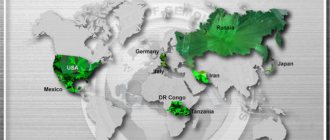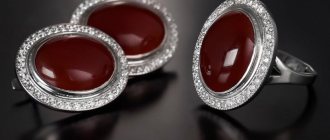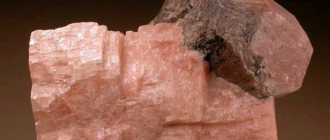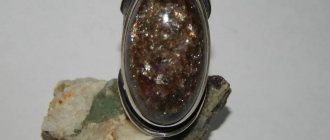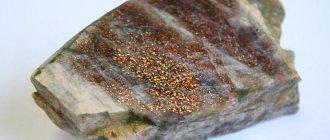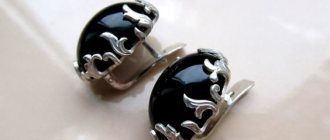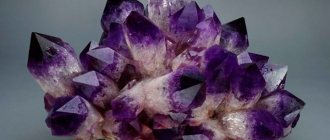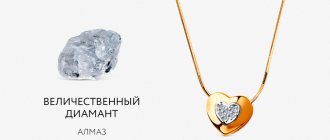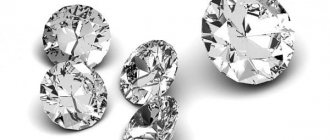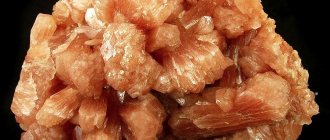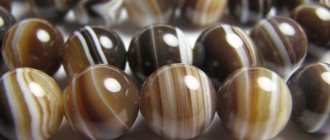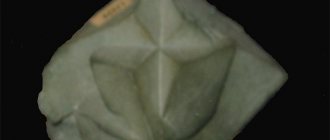The rock-forming mineral orthoclase, despite the fact that it is not a precious stone, is endowed with important characteristics: an attractive appearance, healing and magical properties. And although this crystal has been known to mankind since ancient times, the scientist A. Breithaupt first provided the world with a description of the stone in 1823. Now orthoclase is used in construction, medicine and the ceramics industry.
What is orthoclase? Origin
Orthoclase is a rock-forming mineral from the silicate class.
It is a type of feldspar (potassium feldspar). This mineral has been known to people for a long time, but its scientific description appeared only in 1823 . The scientist August Breithaupt not only described, but also gave the name to the stone due to its structure. “Orthos” translated from ancient Greek means straight, “clasus” means crack, break. The angle between the cleavage planes is really straight (90°) , and if the stone splits, the fragments turn out to be rectangular.
The origin of orthoclase is magmatic, post-magmatic and metamorphic. Like other potassium-sodium spars, it is found primarily in acidic igneous rocks. Sometimes the stone is a perfect crystal, clear, transparent, slightly yellowish. Such specimens are found in Madagascar. The most famous variety of orthoclase is adularia (moonstone).
How to distinguish a fake?
Natural stone is characterized by minor flaws, such as inclusions, cleavage, and microcracks. To distinguish natural orthoclase from a fake, it is recommended to take a closer look at the stone, pointing it at sunlight or using a magnifying glass.
If upon examination a cleavage is discovered that gives an original refraction, bubbles or cracks, the conclusion arises that the stone is of natural origin. But if the stone has no defects, is absolutely clean and bright, then the sample is a fake.
Also read: Magnesite - a talisman with an ancient history
Orthoclase: formula, properties
Orthoclase is a silicate, a potassium variety of the feldspar class. According to the chemical formula, it is a complex of potassium and aluminum oxides plus silicon dioxide. The last component occupies two-thirds of the volume of the mineral.
- Chemical formula - K( AlSi3 O8) or K2O Al2O3 6SiO2.
- Color - from light yellow and pink to reddish. Yellowish, sometimes bluish or colorless - adularia. Yellowish to pale red, blue, colorless - sanidine. Yellow - heliolite.
- The color of the line is white.
- The luster is glassy, pearlescent on the cleavage planes.
- Transparency - opaque, translucent along a thin edge. Some varieties are translucent, but can also be transparent.
- Hardness - 6.
- Density - 2.56 g / cm3 .
- Cleavage - runs in two directions that form a right angle. In one direction it is average, in another it is perfect.
- The shape of the crystals is columnar, prismatic, tabular, Carlsbad twins (twins fused along the lateral face of D4) are often found.
- The crystal structure is silicate with an infinite three-dimensional framework ( Si, Al) C>4 .
Orthoclase is a brittle mineral. Soluble in nitric acid.
Chemical composition:
- silicon dioxide (SiO2) - 64,7 %;
- aluminum oxide (Al2O3) - 18,4 %;
- potassium oxide (K2O) - 16,9 %;
- sodium oxide (Na2O) - not always present .
If the amount of sodium exceeds the amount of potassium, the mineral is called anorthoclase (sodium orthoclase).
Caring for stone products
It is known that the mineral is fragile, so you have to protect the jewelry from mechanical damage and try not to hit or drop the jewelry. To avoid inadvertently damaging the crystal, it is better to store it separately from other treasures. A box or case lined with velvet inside is suitable for this purpose.
Feldspars dissolve in acid, therefore, it is better to avoid contact of chemical components with orthoclase. It is recommended to wash off dirt with soapy water and running water.
Dry at room temperature or with a soft cloth. It is advisable to protect the jewelry from direct sunlight and hot air flow, hair dryer or heating device. This destroys the structure, makes the stone dull and changes color.
Place of Birth
This mineral is widespread and is mined in different parts of the world. In different deposits, stones differ in composition and color. Orthoclase is mined in the following regions:
- in Myanmar, Sri Lanka, India - this “gem triangle of Southeast Asia” is the main supplier of orthoclase jewelry samples;
- in the Czech Republic, Austria, Germany, USA, Mexico, Kyrgyzstan (in the Pamirs) - there are large deposits;
- in Madagascar - the island is famous for its transparent specimens with a yellowish tint (heliolites). Cut stones from there weigh more than 100 carats ;
- in Brazil, Italy, Australia;
- in Russia: in the Urals (Cherry and Ilmen Mountains), the Kola Peninsula, Khabarovsk Territory, Transbaikalia.
Varieties
The appearance and physical characteristics of various samples of orthoclase have led to the identification of several varieties of this stone:
- Adularia (moonstone) is the most famous variety of orthoclase. The color is yellowish, sometimes with a bluish shimmer, similar to the shine of a lunar path on water. This glow occurs due to the thin-plate structure of the stone. Semi-transparent or slightly transparent. Tender silver samples from Sri Lanka are valued above others. Adularia is processed with domed cabochons.
- Sanidine is a mineral with a warm range of colors (from yellowish to red-white) or colorless. Blue specimens with an opalescent effect are very rare. This variety resembles glass with tiny square inclusions that sparkle in the light. Mined in the USA and Germany.
- Heliolite (sunstone) is a transparent yellow variety. After cutting it acquires an amazing golden shine.
- Transparent stones with a blue-green tint are found in the pegmatites of Zimbabwe. In beauty they are not inferior to the aquamarine that lies right there. But specimens of 5 carats and larger are rare.
In gemology and jewelry, orthoclases are also divided according to color:
- water orthoclase is a completely colorless mineral;
- lennilit - green;
- erythritol is a red-colored stone;
- ferriorthoclase - yellow;
- “wolf eye” - with iridescence of pearl-grayish shades.
Read also: Belomorite - a stone donated by the North
Description and history
The first full-fledged study was carried out and a description of the stone was given by a scientist from Germany, A. Breithaupt in 1823. He also gave it a name. The origin of the name comes from the Greek words ὀρθός (orthos - straight) and κλάσις (kalos - crack, to split), given due to the peculiarity of the mineral, its cleavage planes form an angle of 90 degrees.
The crystals look like opaque glass with a pearlescent sheen. The color is often white, sometimes yellowish, pale pink, reddish (if there is an admixture of iron), even a fleshy shade, gray or greenish. Rare transparent and colorless varieties are called adularia. Such stones can have a bluish-silver tint and are popularly called “moonstone”. Opaque gems with a golden sheen are called “sun stone”.
Application
Orthoclase has found application in several areas.
Industry
The mineral is used as a raw material for the production of:
- glass;
- ceramics;
- building material;
- electrical insulators;
- dental mixtures;
- porcelain and earthenware products;
- glazes, enamels.
Jewelry
Jewelers make cabochons from orthoclase, which are used as inserts in jewelry (rings, rings, pendants, earrings).
Particularly impressive are the moon and sun stones, which sparkle in the sun. Some specimens exhibit the effect of cat's eye and asterism.
Other areas
This gem is used in decorative and applied arts due to its ease of processing due to its low density. Products made from this stone such as keychains, pyramids, balls, and various figurines are very popular.
Collectors of mineralogical collections greatly value unusual specimens of orthoclase. Such specimens are often much more expensive than jewelry.
Name compatibility
Each of us is given a name at birth, which, one way or another, influences our destiny. There are no names that are incompatible with orthoclase, but there are those that are ideal for it. This:
- Vasily - self-discovery and spiritual development;
- Eduarda - a decrease in commercialism;
- Julius - implementation of plans;
- Peter – reduction of excessive demands;
- Julia - the ability to make the right choice;
- Melania – stabilization of the emotional background;
- Emma – reduction of irritability.
From the above, we can conclude that the orthoclase mineral is rich in a variety of its representatives, each of which has its own advantages. Its fairly widespread use in industry and jewelry, its benefits in the fight against illnesses and its positive effect on a person’s emotional state confirm this.
Orthoclase is the most common mineral in the world. The stone attracts attention not only due to its availability, but also due to the variety of representatives of its kind, which are not only beautiful, but also multifunctional and practical.
Medicinal properties
The centuries-old practice of healers has revealed and confirmed the healing power of orthoclase:
- Its main healing property is maintaining mental health. A transparent stone helps a person get out of depression and calm down. It reduces irritability and aggression, protects against impulsive actions.
- It is a palliative remedy for cancer. It does not stop the disease, but it increases the effectiveness of medications.
You should not rely on stone treatment alone. Be sure to follow your doctor's instructions.
- Strengthens the immune system, reducing the risk of disease.
Magic properties
Esotericists have noted the following magical properties of orthoclase:
- Depressant. The mineral calms emotional storms, boiling passions, and eliminates depression. Orthoclase is of particular importance for an overly emotional person, as it is able to keep him from rash words and actions.
- Love talisman. This stone can help awaken love in a person who could not define his feelings. But the gem cannot be used as a love spell: it does not tolerate this.
- Family amulet. Orthoclase has a reputation as the guardian of marriage and family hearth. It is appropriate to give it for a wedding.
- Creation. The gem activates creativity and helps to focus on the task at hand. This is very useful for absent-minded, daydreaming people. A talisman made of orthoclase in the form of a ring is suitable for writers, artists, and inventors. It will help you find inspiration.
During creative stagnation, esotericists advise communicating with a stone and asking it for help in finding inspiration.
The difference between orthoclase and fake
Upon careful study of orthoclase, you can notice its main differences from a fake stone:
- cleavage – perfect in one direction and with a right angle between the planes in the other;
- genuine refraction of light when sunlight hits the stone;
- natural inclusions and defects in the form of cracks and air bubbles.
The absence of defects in the structure, unnaturally bright color and purity are evidence that the stone passed off as orthoclase is fake.
Who is suitable according to their zodiac sign?
According to the horoscope, orthoclase (except for its variety heliolite) is suitable for Cancer and Pisces . These zodiac signs have full compatibility with the stone, so it will provide support in everything. Help in creative activity, developing intuition, and achieving mental balance will be especially noticeable.
An orthoclase talisman helps only people who are not inclined to harm others and are not committed to black magic.
Astrologers do not recommend wearing orthoclase to the zodiac signs of the element of Fire (Aries, Leo, Sagittarius), as it can cause melancholy and pessimism. But according to the horoscope, these signs are fully compatible with heliolite. For people born under the constellations Aries, Leo and Sagittarius, spinel and ruby are perfect. In addition, amber is also a lucky stone for Sagittarius and Leo.
Also suitable according to the horoscope:
- For Sagittarius - lapis lazuli, ulexite, chalcedony, blue sapphire, blue quartz.
- For Leo - diamond, rock crystal, golden quartz, chrysoberyl, black diamond.
- For Aries - creole, emerald, tanzanite.
Orthoclase and Zodiac
Orthoclase suits the horoscope of Pisces and Cancer. They have complete compatibility, the stone will provide support in everything. Especially in creative work, development of intuition, mental balance. But only if a person is not committed to the dark sides of arcane knowledge and does not intend to harm his neighbor.
Astrology does not recommend the stone for fire signs. He will drive Sagittarius, Leo, and Aries into pessimism and melancholy.
For other zodiac signs, this is a super talisman against ill-considered decisions and rash actions.
Price
Prices for orthoclase on the world market depend on:
- dimensions;
- quality;
- colors.
The cost of 10-carat medium-quality stone is $300 .
A well-cut yellow specimen costs $100–120 per carat .
The gem can be bought not only in jewelry stores, but also in online stores. Examples of prices (in rubles) :
- ring with moonstone (silver) - 1250;
- lemon yellow orthoclase (cut, 47.47 carats, 26.6 x 26.4 x 13.5 mm) - 25000;
- orthoclase with aegirine - collection material (60 x 45 x 40 mm) - 2650.
